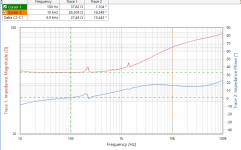If you have an ultra low noise power supply would it hurt to fit an analogue meter like this to its output:
1PC DC 0 10A Analog Ammeter Panel AMP Current Meter SO45 Panel Cutout Dia.:45mm directly Connect-in Instrument Parts & Accessories from Tools on AliExpress
Presume you'd just cut into the output on one side neg or pos.
Looks cool but would be interesting to see the current fluctuations too.
1PC DC 0 10A Analog Ammeter Panel AMP Current Meter SO45 Panel Cutout Dia.:45mm directly Connect-in Instrument Parts & Accessories from Tools on AliExpress
Presume you'd just cut into the output on one side neg or pos.
Looks cool but would be interesting to see the current fluctuations too.
If you have an ultra low noise power supply would it hurt to fit an analogue meter like this to its output:
1PC DC 0 10A Analog Ammeter Panel AMP Current Meter SO45 Panel Cutout Dia.:45mm directly Connect-in Instrument Parts & Accessories from Tools on AliExpress
Presume you'd just cut into the output on one side neg or pos.
Looks cool but would be interesting to see the current fluctuations too.
Will add noise to the power supply.
Will add noise to the power supply.
Thought it might but needed to ask
Any time you put a sense resistor (or meter shunt) between the supply and load you're increasing the output impedance of the supply. A really great low noise regulator like the Jung has output impedance in the tens of micro-Ohms so it defeats the effort you've one to assure low impedance, low noise.
I'd follow Mark's direction -- just remember that the regulator is going to draw current of its own.
I'd follow Mark's direction -- just remember that the regulator is going to draw current of its own.
What "low noise" box needs a 10 AMP meter??
If you must: measure the current INTO the regulator. This will include the regulator's current and any wobble in it. Typically this will be small compared to load, and fairly steady.
No won't be doing it - asked here before purchase and got good advice.
Why 10 amps because the power supply is capable of delivering 6 at 24 Volts
Agree on it s adding an impedance in series with voltage source, by the way I´d expect an inductive component, but would like to know why it might introduce *noise* , I see no mechanism for that.
You're right, the meter and shunt have DC resistance -- for a 1mA meter (salvaged from an HP 400) it's about 38 Ohms. The shunt would have to be ~0.39 Ohm to measure 100 mA, and the inductance is damped by the small parallel resistance. Noise should be trivial.
Attachments
Last edited:
- Status
- This old topic is closed. If you want to reopen this topic, contact a moderator using the "Report Post" button.
- Home
- Amplifiers
- Power Supplies
- Fit Cheap DC Ammeter to Power supply output?
